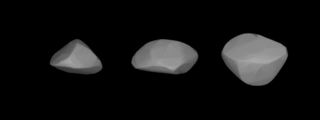 W
WCybele, minor planet designation 65 Cybele, is one of the largest asteroids in the Solar System and is located in the outer asteroid belt. It gives its name to the Cybele group of asteroids that orbit outward from the Sun from the 2:1 orbital resonance with Jupiter. The X-type asteroid has a relatively short rotation period of 6.0814 hours. It was discovered by Wilhelm Tempel in 1861, and named after Cybele, the earth goddess.
 W
WFreia is a very large main-belt asteroid. It orbits in the outer part of the asteroid belt and is classified as a Cybele asteroid. Its composition is very primitive and it is extremely dark in color. Freia was discovered by the astronomer Heinrich d'Arrest on October 21, 1862, in Copenhagen, Denmark. It was his first and only asteroid discovery. It is named after the goddess Freyja in Norse mythology.
 W
WSylvia is the 8th-largest asteroid in the asteroid belt. It is the parent body of the Sylvia family and member of Cybele group located beyond the main asteroid belt. Sylvia was the first asteroid known to possess more than one moon.
 W
WCamilla is one of the largest asteroids from the outermost edge of the asteroid belt, approximately 220 kilometers. It is a member of the Sylvia family and located within the Cybele group. It was discovered on 17 November 1868, by English astronomer Norman Pogson at Madras Observatory, India, and named after Camilla, Queen of the Volsci in Roman mythology. The X-type asteroid is a rare trinary asteroid with two minor-planet moons discovered in 2001 and 2016, respectively. It is elongated in shape and has a short rotation period of 4.8 hours.
 W
WHermione is a very large binary asteroid discovered in 1872. It orbits in the Cybele group in the far outer asteroid belt. As an asteroid of the dark C spectral type, it is probably composed of carbonaceous materials. In 2002, a small moon was found to be orbiting Hermione.
 W
WHuberta is a large asteroid orbiting near the outer edge of the Main belt. It is dark and rich in carbon.
 W
WRezia is a minor planet orbiting the Sun. It was discovered by Max Wolf on March 20, 1904. It is named for a character in the 1826 opera Oberon by Carl Maria von Weber. Among the 248 discoveries by Wolf, he also discovered 527 Euryanthe and 529 Preziosa on the same day.
 W
W643 Scheherezade is a minor planet orbiting the Sun. It was named after the fictional storyteller Sheherazad.
 W
W692 Hippodamia, provisional designation 1901 HD, is a stony asteroid from the outer region of the asteroid belt, about 45 kilometers in diameter. It was discovered on 5 November 1901, by the German astronomers Max Wolf and August Kopff at Heidelberg Observatory in southern Germany. Nine years later, the body was rediscovered by August Kopff at its apparition in 1910.
 W
W909 Ulla is a large and dark asteroid from the outermost regions of the asteroid belt, that measures approximately 116 kilometers in diameter. It is the parent body and namesake of the Ulla family, which belongs to the larger group of Cybele asteroids. It was discovered on 7 February 1919, by German astronomer Karl Reinmuth at the Heidelberg Observatory in southwest Germany. The X-type asteroid has a rotation period of 8.7 hours and a notably low value for its Jupiter Tisserand's parameter. It was named after Ulla Ahrens, daughter of a friend of the discoverer.